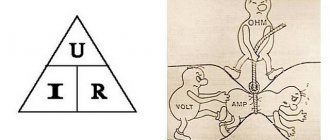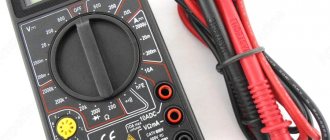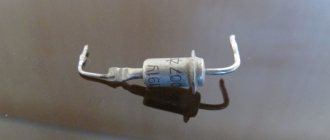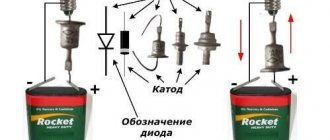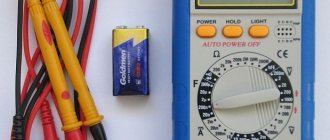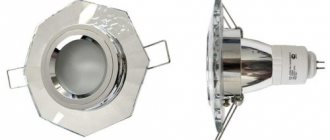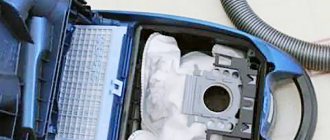Wiring type and its parameters
At home, you most often have to deal with alternating current, much less often with direct current.
Typically, direct current is measured in batteries and batteries; house wiring always runs on alternating current. Even if the electrical network is powered by batteries (a backup power source, the main one in the absence of a centralized power supply), it must contain an “adapter” - a device that converts direct current into alternating current. When figuring out how to measure current with a multimeter, you need to clearly understand: to work with direct current, use the DCA (A-) segment of the multimeter, for measuring alternating current, use the ACA (A~) sector. The designations are associated with abbreviations of English terms: direct current amperage (DCA) and alternating current amperage (ACA) is the designation of alternating current on a multimeter.
Typically, multimeters allow you to measure microcurrents - up to 200 mA - and stronger ones (up to 10A). Devices that allow measurements in more powerful electrical networks have an additional socket for a plug (probe) marked 20A. Typically, in models with four connectors, two are designed to measure current in different ranges, one is for other measurements (voltage, resistance).
The COM (COMMON) connector, common (universal) for all types of measurements, is intended for the negative (black) probe of the multimeter.
Thus, to measure current with a multimeter, you need to connect the black probe to the COM connector, and the red probe to the socket for checking microcurrents or ordinary currents. For sockets and switches, the device regulator is set to the alternating voltage sector, for batteries and batteries - constant. If the level is unknown in advance, the highest value allowed by the device is selected.
Important: if no energy-consuming device is connected to the outlet (on the switch), the electrical circuit is open and there is no current in it!!! Measuring the current directly in the socket or on the contacts of the switch is useless and dangerous! This causes a short circuit.
Preparing for work
First, you need to turn the switch handle to the marks of the sector indicated by the symbol “A”. To measure DC and AC values, different sectors are provided. They can be indicated by the symbols:
- three dots under a straight horizontal line - for direct current;
- wavy line - for variable.
The letter designations look like this:
- "DCV" - for permanent;
- "ACV" - for alternating current.
Care and compliance with the instructions when taking measurements will help you avoid mistakes and not break the multimeter.
Next you need to insert the cables into their sockets. Black - with the designation “COM” or “−”. Red with the designation “VΩmA”. There are contacts at the other ends of the cables. They will connect to the measured network.
Why do you need to measure current?
The voltage and resistance of the electrical circuit, which are measured in units such as volts (V) and ohms, respectively, have a significant impact on the amount of current. In this case, an increase in voltage with a constant resistance of the electrical circuit causes an increase in current strength, and an increase in the resistance of the circuit with a constant voltage value leads to its decrease. Current (I), voltage (U) and resistance (R) depend on each other and are related by empirical formulas:
- I = U/R
- U = I*R
- R = U/I
In this case, it is simplified to assume that a current of 1 A appears in a conductor with a resistance of 1 Ohm if a voltage of 1 V is applied to it.
Current measurement
By measuring the CT with a multimeter, you can:
- clarify the actual power consumption of a particular electrical appliance;
- find defects in an electrical appliance if its actual power does not correspond to the value stated in the documentation;
- find out the electrical capacity of autonomous power sources (batteries, etc.);
- identify the existence of current leakage in electrical circuits and, if necessary, localize the defective area;
- check the battery charger to ensure that the charging current corresponds to the specified value, etc.
Such measurements are carried out using special instruments - ammeters. There are enough varieties of them on the domestic market to satisfy the needs of all buyers.
The most popular, especially at the household level, are small multifunctional (ammeter + ohmmeter + voltmeter) multimeters, with which you can measure almost all the necessary parameters of an electrical circuit.
How can you check if an ammeter is reading correctly using another ammeter?
Current strength is measured not only for laboratory work in physics. Any DIYer who assembles electrical circuits needs to accurately measure the parameters of electrical circuits.
- Checking the parameters of the transformer, homemade power supply
- Search for battery leakage currents in a car's electrical circuit. This is the most popular application of an ammeter
- Charging the battery with manual settings.
Everyone has long been accustomed to using digital multimeters without thinking about the accuracy (more precisely, the error) of the device’s measurements.
Instrumentation electricians know how to calibrate measuring instruments. There are repair and testing bases at every enterprise. We all remember that any device must have a verification stamp, and the documentation indicates the date of the last measurement, the frequency of this procedure, and the validity period.
But what about popular universal devices that are sold in radio markets, electrical goods stores or on Chinese Internet sites? The maximum that can be achieved from the seller is semi-legal paper (passport or instructions), which indicates the measurement error.
Digital multimeter
The most convenient is a multimeter, in which it is enough to simply set a specific measuring mode. There is no need to additionally specify the tolerance range, since the device itself adapts to the circuit parameters, takes measurements and produces the required result.
The image below shows the first position of the handle, which has several positions demonstrating AC and DC voltage. The first is indicated by V AC (~ symbol), the last DC (—), in the range of volts and millivolts. The current strength A is similar, not being divided into current types, but having a gradation in amperes and milliamps.
In addition, the function of measuring resistance and chain ringing is mandatory.
At the bottom there are several sockets used to activate the measurement wires. The socket marked with the second position COM is used for the main black wire. The third position shows the socket for making basic measurements using the red cord. The permissible limits for voltage and current measurements are shown below. The fourth socket, indicated by position 4 in the image, is used to measure current in amperes, with a maximum limit of no more than 10 A. All readings appear on the display with digital graphics, which is indicated by position 5.
A multitester with an indication of the measurement range is more common, primarily because it costs much less.
When using a multimeter, it is necessary to indicate both the operating mode and the alternating and constant currents. In the same sector, a switch is installed in the required measuring range, expressed in mA, µA and A. The example shown shows 4 socket connections. Two of them are for red wires, measuring up to 200 mA and up to 10 A. Voltage, resistance, capacitance and other indicators are measured using a separate socket.
Briefly about the device
Each tester has two outputs. For connecting wires with probes. The connection socket may be larger, but we need a red one to connect the probe to the phase and a black one for the neutral wire. There may be sockets for taking measurements of all values. Namely:
tension;- resistance;
- current strength.
To designate nests, a designation using a unit of measurement is used. It's impossible to make a mistake if you haven't skipped physics classes.
The second main element of the measuring device is the setting scale and switch. As a rule, a certain sector is allocated for measuring the current value. Amps are listed here with different numerical values.
Multimeters are available in digital and analogue versions . Digital devices have a larger number of adjustable amperage values, and they are also equipped with sound signals and other options. But this applies to the choice of device type. Each of them will allow you to take measurements, this is the main thing for us.
Let's move on to consider the main topic.
Measurement order
A multimeter for measuring current is connected to an open circuit. This is the main difference from the voltage measurement procedure, in which the tester is connected to the circuit in parallel. The indicator of the amount of current that passes through the device is displayed by an arrow on the scale (if we are talking about an analog device) or is displayed on the liquid crystal (LED) display.
There are different ways to break the circuit under test to connect the device to it. For example, by disconnecting one of the terminals of the radio element using a soldering iron. Sometimes you have to cut the wire with wire cutters or pliers. When determining the current value of a battery or accumulator, such a problem does not exist, since a circuit is simply assembled, one of the elements of which is a multimeter.
Types of Multimeters
All devices, according to their design and principle of measuring current indicators, can be divided into two types:
- Analog testers.
- Digital multimeters.
Briefly about each type of measuring device.
Analog multimeters
The main difference between analog and digital devices is the presence of a digitized scale with an arrow. They are very easy to use and quite cheap. But their disadvantage is considered to be the presence of errors in the readings. Although this can be corrected using a tuning resistor. But, all the same, it is unlikely that it will be possible to achieve accuracy comparable to digital instruments. And in some cases, this is really necessary.
Digital multimeters
Since the presence of a scale with an arrow is mentioned as one of the main differences between analog devices, it is logical to assume that they are absent in digital devices. And indeed it is. The measurement results are displayed on the display, which can be LED or liquid crystal, in the form of specific numbers.
As already mentioned, the main advantage of digital testers is the accuracy of current measurement. In addition, they are not much more difficult to use than analog ones. Even a beginner can cope with measurements after a short instruction. The downside is the higher cost of a digital device.
Basic principles of current measurement
The main condition that must be met when measuring current in an electrical circuit is to connect the tester to a wire break in this circuit, that is, to become its component during the measurement. Before measuring the current strength with a multimeter, it is equally important to correctly set the following on the device:
- measurement mode (DC or AC);
- upper measurement limit.
Incorrectly set parameters will certainly lead to breakdown of the measuring device.
When the user does not know the magnitude of the current in the circuit, it is necessary to set the maximum measurement limit. If the set range turns out to be too high, it is gradually reduced using the tester operating mode switch.
A device for measuring current is connected in an electrical circuit in series with the load. When measuring large currents, the multimeter is connected to the circuit through a current transformer, shunt or magnetic amplifier. If measurements need to be carried out in electrical circuits with a voltage of more than 1 kV, use a current transformer (alternating current) or a magnetic amplifier (direct current).
How to check the ammeter for serviceability at home?
The most win-win option is to give the ammeter (multimeter) to metrologists. Each city has a certification and standardization laboratory with a wide range of repair and testing equipment. Typically, this organization accepts complaints about product non-compliance with standards.
Your device will be checked for serviceability, measurement accuracy will be verified, and an appropriate certificate will be issued. They will even put a stamp at your request. There is one problem: this service costs some money. Considering the cost of instruments from the Middle Kingdom, the price of the service can be comparable to the price of the verification object.
The second option is to check the correctness using another ammeter. If we omit the most important thing - where to get a known good “other ammeter”, the procedure is simple.
- An electrical circuit is assembled from a power source and a reliable consumer. It is better to take a powerful resistor with a good cooling area. Then the current in the circuit will be stable and will not change due to heating of the resistance. Using Ohm's law, calculate the voltage of the power source and the resistance of the resistor. To check the accuracy of the measurement in different ranges, a variable resistor is added in series to the circuit. The current strength must be adjusted within the scale of the device being tested.
- Connect the power, set the resistance of the tuning resistor R2 so that the instrument needles are in the middle of the scale. This is the point with the smallest error. Wait a few minutes, watching the resistors heat up. If the device readings do not deviate from the original value, the circuit is suitable for verification.
- You regulate the current strength with a variable resistor, fixing the value at each division of the main marking of the reference device. Record the readings of the ammeter being tested. After going through the entire scale, you will have a picture of the instrument's error.
- Next, you can remember the difference in readings, make adjustments to the device (if there is an adjusting screw) or apply new markings in accordance with the readings of the standard. In fact, this is the calibration of an ammeter.
How to correctly check the current in a socket with a multimeter
You cannot insert probes into the socket to the phase and zero contacts; to perform the test, you must connect a “load,” that is, any electrical appliance.
Below is a diagram for measuring the current of a transformer; a regular incandescent lamp is connected to its contacts as a load. As can be seen from the display readings, the current is 1.14 A. It is important to understand that in the home electrical network the indicators are higher, so you should not take risks by directly “shorting” phase and zero with multimeter probes.
In fact, the following sequence of actions is performed to check:
- the current in the socket selected for measurements is turned off (automatically on the panel). You can check whether the outlet is connected or not by measuring the voltage with a multimeter. This procedure is safe even under load;
- The front (protective part) is removed from the socket so that there is direct access to the contacts. After this, a contact is connected to one of them, for example, a phase one, through a terminal block from the plug (wire) of any low-power electrical appliance - a table lamp, for example;
- further, as shown in the illustration, also through the terminal blocks, the free pin of the plug (lamp wire) to one of the probes, the free contact of the socket to the other. In most modern multimeters, the polarity of the connection (where to connect the positive probe, where the negative probe) is not important, the readings on the display will be the same. If the polarity is reversed, a “-” sign will appear next to the numbers;
- After the connections have been made, the socket will be automatically plugged back into the general house circuit. After turning the lamp switch to the “ON” position, measurements can be taken. The current will vary for different consumer devices. So, when connecting a regular incandescent lamp, the current will be about half an ampere.
Direction of electric current in metals
Negatively charged electrons move along metal wires, i.e. current flows from “–” to “+” source. The direction of electron motion is called real. But historically in science, the conditional direction of current is accepted from “+” source to “–”.
Actions of electric current (energy conversion)
Electric current can cause various actions:
- Thermal - electrical energy is converted into heat. This transformation is provided by an electric stove, electric fireplace, and iron.
- Chemical - electrolytes undergo electrolysis under the influence of direct electric current. During electrolysis, negative ions (anions) are attracted to the positive electrode (anode), and positive ions (cations) are attracted to the negative electrode (cathode).
- Magnetic (electromagnetic) - in the presence of an electric current in any conductor, a magnetic field is observed around it, i.e. a conductor carrying current acquires magnetic properties.
- Luminous - electric current heats metals to white heat, and they begin to glow like a tungsten spiral inside an incandescent lamp. Another example is LEDs, in which light comes from the emission of photons as an electron moves from one energy level to another.
- Mechanical - parallel conductors with electric currents flowing in one direction attract, and in opposite directions they repel.
How to measure current with a multimeter on a battery
Any machine has its own minimum amount of current leakage, which varies, in amperes, from 0.01 to 0.08. First, it’s worth understanding the causes of current leakage in the car. One of them may be that the owner simply forgot to turn off the lights, for example.
There are cars that have a bad factory design built into them. This can be considered a glass heating system, which conducts its power chain bypassing the ignition switch. Let’s not forget about children who love to sit in the driver’s seat, turning various instrument levers.
The second global reason may be an incorrect connection. Thus, during the period of global interest among car enthusiasts in music and radios, the battery charge was melting before our eyes. This happened because the installers did not know how to connect the devices correctly. One ignition wire passed through the ignition switch did the job. If you have an anti-theft system installed, and the next morning you find an empty battery, then there is no need to guess.
We also advise you not to leave recorders, radars and other devices in cigarette lighters and sockets. Not all cars provide them when the ignition is not working.
Multimeter accuracy
Depending on the complexity, the device can have from 2.5 (simple) to 8.5 (precise) screen digits. The most common devices with 3.5 boot. The bit indicates that the device can represent a number of bits from 0 to 9 in whole or in part. For example, for 3.5 digits, measurements ranging from 0.000 to 1.9999 are possible. If the value is outside the specified range, manual or automatic switching to another range is necessary.
The accuracy of the operation does not depend directly on the bit, although there is a relationship. Consequently, for devices with a discharge measurement error of 2.5 approximately 10%, for devices from 4.5 to 0.1%. At a depth slightly greater than 5, the accuracy is specified separately for each type of measurement and can reach 0.01%.
Stationary instruments generally have higher accuracy than portable instruments.
How to measure DC voltage with a multimeter
Let's take a battery like this. As we can see, it says a current of 550 mAh, which it can supply to the load for an hour, that is, milliamps per hour, as well as the voltage that our battery has - 1.2 Volts. Voltage is understandable, but what is “current for an hour”? Let's say our load, a light bulb, consumes a current of 550 mA. This means the light bulb will shine for one hour. Or let's take a light bulb that shines weaker, and let it consume 55 mA, which means it can work for 10 hours.
We divide the 550 mA value that is written on the battery by the value that is written on the load and get the time during which all this will work until the battery runs out. In short, anyone who is good at mathematics will not have any difficulty understanding this miracle.

